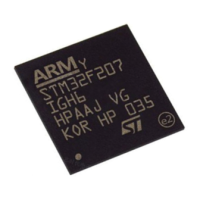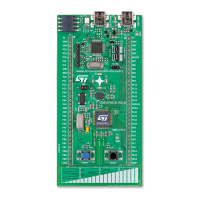RM0008 Universal serial bus full-speed device interface (USB)
Doc ID 13902 Rev 12 623/1096
Bits 10:9 EP_TYPE[1:0]: Endpoint type
These bits configure the behavior of this endpoint as described in Table 173: Endpoint type
encoding on page 624. Endpoint 0 must always be a control endpoint and each USB
function must have at least one control endpoint which has address 0, but there may be
other control endpoints if required. Only control endpoints handle SETUP transactions,
which are ignored by endpoints of other kinds. SETUP transactions cannot be answered
with NAK or STALL. If a control endpoint is defined as NAK, the USB peripheral will not
answer, simulating a receive error, in the receive direction when a SETUP transaction is
received. If the control endpoint is defined as STALL in the receive direction, then the
SETUP packet will be accepted anyway, transferring data and issuing the CTR interrupt. The
reception of OUT transactions is handled in the normal way, even if the endpoint is a control
one.
Bulk and interrupt endpoints have very similar behavior and they differ only in the special
feature available using the EP_KIND configuration bit.
The usage of Isochronous endpoints is explained in Section 23.4.4: Isochronous transfers
Bit 8 EP_KIND: Endpoint kind
The meaning of this bit depends on the endpoint type configured by the EP_TYPE bits.
Tabl e 1 74 summarizes the different meanings.
DBL_BUF: This bit is set by the software to enable the double-buffering feature for this bulk
endpoint. The usage of double-buffered bulk endpoints is explained in Section 23.4.3:
Double-buffered endpoints.
STATUS_OUT: This bit is set by the software to indicate that a status out transaction is
expected: in this case all OUT transactions containing more than zero data bytes are
answered ‘STALL’ instead of ‘ACK’. This bit may be used to improve the robustness of the
application to protocol errors during control transfers and its usage is intended for control
endpoints only. When STATUS_OUT is reset, OUT transactions can have any number of
bytes, as required.
Bit 7 CTR_TX: Correct Transfer for transmission
This bit is set by the hardware when an IN transaction is successfully completed on this
endpoint; the software can only clear this bit. If the CTRM bit in the USB_CNTR register is
set accordingly, a generic interrupt condition is generated together with the endpoint related
interrupt condition, which is always activated.
A transaction ended with a NAK or STALL handshake does not set this bit, since no data is
actually transferred, as in the case of protocol errors or data toggle mismatches.
This bit is read/write but only ‘0 can be written.
Bit 6 DTOG_TX: Data Toggle, for transmission transfers
If the endpoint is non-isochronous, this bit contains the required value of the data toggle bit
(0=DATA0, 1=DATA1) for the next data packet to be transmitted. Hardware toggles this bit
when the ACK handshake is received from the USB host, following a data packet
transmission. If the endpoint is defined as a control one, hardware sets this bit to 1 at the
reception of a SETUP PID addressed to this endpoint.
If the endpoint is using the double buffer feature, this bit is used to support packet buffer
swapping too (Refer to Section 23.4.3: Double-buffered endpoints)
If the endpoint is Isochronous, this bit is used to support packet buffer swapping since no
data toggling is used for this sort of endpoints and only DATA0 packet are transmitted (Refer
to Section 23.4.4: Isochronous transfers). Hardware toggles this bit just after the end of data
packet transmission, since no handshake is used for Isochronous transfers.
This bit can also be toggled by the software to initialize its value (mandatory when the
endpoint is not a control one) or to force a specific data toggle/packet buffer usage. When
the application software writes ‘0, the value of DTOG_TX remains unchanged, while writing
‘1 makes the bit value toggle. This bit is read/write but it can only be toggled by writing 1.

